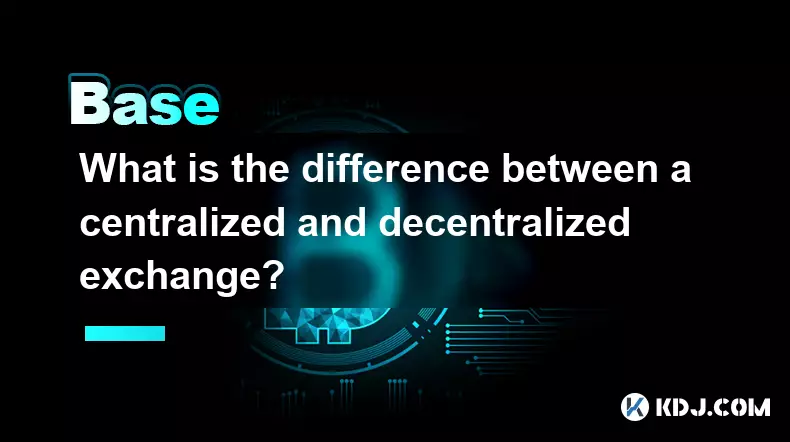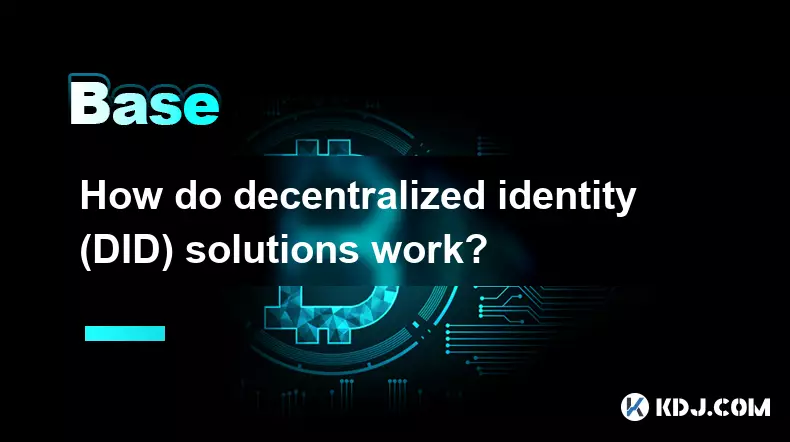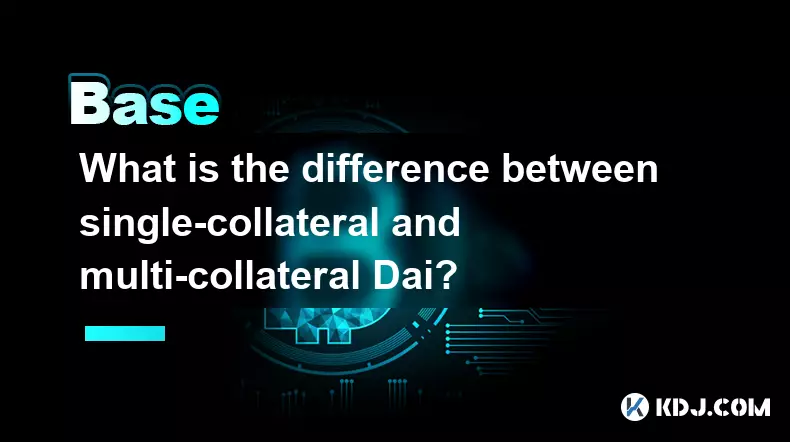-
 bitcoin
bitcoin $106975.071866 USD
-0.29% -
 ethereum
ethereum $3871.670850 USD
-0.07% -
 tether
tether $1.000261 USD
-0.01% -
 bnb
bnb $1084.417621 USD
-0.50% -
 xrp
xrp $2.348167 USD
0.82% -
 solana
solana $185.621736 USD
0.45% -
 usd-coin
usd-coin $0.999833 USD
-0.04% -
 tron
tron $0.313423 USD
0.81% -
 dogecoin
dogecoin $0.188856 USD
0.54% -
 cardano
cardano $0.630416 USD
-0.49% -
 hyperliquid
hyperliquid $36.506353 USD
2.24% -
 ethena-usde
ethena-usde $0.999584 USD
-0.01% -
 chainlink
chainlink $16.750026 USD
-0.77% -
 stellar
stellar $0.313373 USD
0.37% -
 bitcoin-cash
bitcoin-cash $465.978560 USD
-1.57%
What is the difference between a centralized and decentralized exchange?
Decentralized exchanges (DEXs) eliminate single points of failure by design, reducing theft risks as users retain control of their funds through non-custodial wallets.
Aug 29, 2025 at 11:01 am

Understanding Centralized Exchanges
1. Centralized exchanges, commonly referred to as CEXs, operate under a single authority that manages all aspects of trading, including order matching, custody of assets, and user verification. This structure mirrors traditional financial institutions like stock exchanges.
2. Users on centralized platforms must deposit their cryptocurrencies into wallets controlled by the exchange. This means the exchange holds the private keys, making users reliant on the platform’s security and operational integrity.
3. These exchanges typically offer high liquidity, fast transaction processing, and advanced trading tools such as margin trading, stop-loss orders, and algorithmic execution, which appeal to both novice and experienced traders.
4. Regulatory compliance is a major feature of centralized exchanges. They often require users to complete KYC (Know Your Customer) and AML (Anti-Money Laundering) procedures, which enhances legitimacy but reduces anonymity.
5. Due to their central point of control, these platforms are frequent targets for hackers. High-profile breaches, such as the Mt. Gox and Bitfinex incidents, highlight the risks associated with asset custodianship by third parties.
The Mechanics of Decentralized Exchanges
1. Decentralized exchanges, or DEXs, operate on blockchain networks using smart contracts to facilitate peer-to-peer trading without intermediaries. There is no central authority overseeing transactions or holding user funds.
2. Users retain control of their private keys and assets through non-custodial wallets like MetaMask or Trust Wallet. Trades are executed directly from these wallets, ensuring that ownership remains with the individual at all times.
3. Most DEXs rely on automated market maker (AMM) models, where liquidity is provided by users who deposit assets into liquidity pools. In return, they earn a share of the trading fees generated on the platform.
4. Because there is no central server or entity, DEXs are resistant to censorship and downtime. They function as long as the underlying blockchain is operational, offering a high degree of resilience against shutdowns or regulatory pressure.
5. While DEXs promote transparency and user sovereignty, they often face challenges such as lower liquidity, higher slippage on large trades, and a steeper learning curve for new users unfamiliar with wallet management and gas fees.
Security and Control in Crypto Trading Platforms
1. On centralized exchanges, security depends heavily on the platform’s infrastructure, including cold storage solutions, multi-signature wallets, and internal audit protocols. However, the concentration of assets makes them attractive targets.
2. Decentralized exchanges eliminate single points of failure by design, reducing the risk of large-scale theft. Since funds never leave the user’s wallet, the attack surface is significantly smaller.
3. Users on DEXs must take personal responsibility for security. Misplacing a private key or interacting with a malicious smart contract can result in irreversible loss of funds, with no customer support to recover assets.
4. Centralized platforms often provide customer service, account recovery options, and fraud protection mechanisms, which are absent in decentralized environments.
5. The trade-off between convenience and control defines the security landscape: CEXs offer ease of use at the cost of trust, while DEXs demand technical awareness in exchange for full autonomy.
Regulatory and Operational Differences
1. Centralized exchanges are subject to jurisdictional laws and must often register as financial institutions. They are required to report transactions and freeze accounts when legally compelled.
2. Decentralized exchanges operate across borders without a central headquarters, making them difficult to regulate. Their open-source nature allows anyone to deploy or interact with them, regardless of location.
3. Governments have begun targeting DEX developers, frontend providers, or liquidity facilitators in attempts to impose oversight, but enforcement remains inconsistent due to the distributed nature of these systems.
4. CEXs may delist tokens that fail to meet compliance standards, while DEXs typically list any token as long as it exists on the supported blockchain, increasing access but also exposure to scams.
5. Transaction transparency differs as well. While all blockchain activity is public, CEXs obscure on-chain movement by batching withdrawals and using internal ledgers, whereas DEX trades are directly visible on the blockchain.
Frequently Asked Questions
What happens if a decentralized exchange’s smart contract has a bug?Smart contract vulnerabilities can lead to exploitation, as seen in several high-profile hacks on DeFi protocols. Funds locked in flawed contracts may be drained, and since transactions are irreversible, losses are often permanent. Audits and community reviews help mitigate this risk but do not eliminate it.
Can I trade with fiat currency on a decentralized exchange?Most DEXs do not support direct fiat on-ramps. Users typically need to purchase stablecoins like USDT or DAI on a centralized exchange and transfer them to a wallet to begin trading on a DEX. Some integrated services now offer fiat entry points, but they are not native to the DEX itself.
Why do some traders prefer centralized exchanges despite the risks?The preference stems from user experience, liquidity, and available features. CEXs offer intuitive interfaces, fast order execution, stop-loss functionality, and customer support—elements that many active traders consider essential for efficient operations.
How do decentralized exchanges handle transaction speed and fees?Transaction speed and cost depend on the underlying blockchain. Ethereum-based DEXs can face high gas fees and network congestion during peak times. Alternatives like Solana or Binance Smart Chain offer faster and cheaper transactions, influencing user choice based on network conditions.
Disclaimer:info@kdj.com
The information provided is not trading advice. kdj.com does not assume any responsibility for any investments made based on the information provided in this article. Cryptocurrencies are highly volatile and it is highly recommended that you invest with caution after thorough research!
If you believe that the content used on this website infringes your copyright, please contact us immediately (info@kdj.com) and we will delete it promptly.
- Dota 2 YouTube Hack: Solana Scam Exposes Esports Security Flaws
- 2025-10-19 18:25:13
- Bitcoin Exchange Exodus: Investor Withdrawals Squeeze Supply, Will Prices Pop?
- 2025-10-19 19:05:12
- Bittensor, BlockchainFX, Crypto Investment: The Next Big Thing?
- 2025-10-19 18:50:12
- MAGACOIN FINANCE: Riding the ETF Buzz for Potential 100x Gains
- 2025-10-19 18:50:12
- Pumpfun's PUMP Price: Comeback Reasons and What's Next!
- 2025-10-19 18:25:13
- OpenSea's SEA Token: Funding the Future of Blockchain Trading
- 2025-10-19 18:55:11
Related knowledge

How do decentralized identity (DID) solutions work?
Oct 14,2025 at 11:36pm
Understanding Decentralized Identity in the Blockchain Ecosystem1. Decentralized identity (DID) solutions are built on blockchain networks, allowing i...

What is the difference between Near Protocol and Ethereum?
Oct 15,2025 at 08:01am
Near Protocol and Ethereum: Core Architectural Differences1. Near Protocol operates on a sharded blockchain architecture known as Nightshade, which al...

What does it mean for code to be "open source" in crypto?
Oct 12,2025 at 01:54pm
Understanding Open Source in the Cryptocurrency Ecosystem1. In the context of cryptocurrency, open source refers to software whose code is publicly ac...

What is the purpose of a "testnet"?
Oct 12,2025 at 09:01am
Understanding the Role of Testnets in Blockchain Development1. A testnet serves as a parallel version of a blockchain network, designed specifically f...

How to avoid phishing scams in crypto?
Oct 13,2025 at 06:18pm
Understanding Common Crypto Phishing Tactics1. Cybercriminals frequently use fake websites that mirror legitimate crypto exchanges or wallet platforms...

What is the difference between single-collateral and multi-collateral Dai?
Oct 12,2025 at 05:18pm
Understanding Single-Collateral Dai1. Single-Collateral Dai (SCD) was the original version of the Dai stablecoin launched by MakerDAO in 2017. It allo...

How do decentralized identity (DID) solutions work?
Oct 14,2025 at 11:36pm
Understanding Decentralized Identity in the Blockchain Ecosystem1. Decentralized identity (DID) solutions are built on blockchain networks, allowing i...

What is the difference between Near Protocol and Ethereum?
Oct 15,2025 at 08:01am
Near Protocol and Ethereum: Core Architectural Differences1. Near Protocol operates on a sharded blockchain architecture known as Nightshade, which al...

What does it mean for code to be "open source" in crypto?
Oct 12,2025 at 01:54pm
Understanding Open Source in the Cryptocurrency Ecosystem1. In the context of cryptocurrency, open source refers to software whose code is publicly ac...

What is the purpose of a "testnet"?
Oct 12,2025 at 09:01am
Understanding the Role of Testnets in Blockchain Development1. A testnet serves as a parallel version of a blockchain network, designed specifically f...

How to avoid phishing scams in crypto?
Oct 13,2025 at 06:18pm
Understanding Common Crypto Phishing Tactics1. Cybercriminals frequently use fake websites that mirror legitimate crypto exchanges or wallet platforms...

What is the difference between single-collateral and multi-collateral Dai?
Oct 12,2025 at 05:18pm
Understanding Single-Collateral Dai1. Single-Collateral Dai (SCD) was the original version of the Dai stablecoin launched by MakerDAO in 2017. It allo...
See all articles





















![[4K 60fps] Astral by oc3andark (1 Coin) [4K 60fps] Astral by oc3andark (1 Coin)](/uploads/2025/10/19/cryptocurrencies-news/videos/k-fps-astral-ocandark-coin/68f438453fa33_image_500_375.webp)




















































